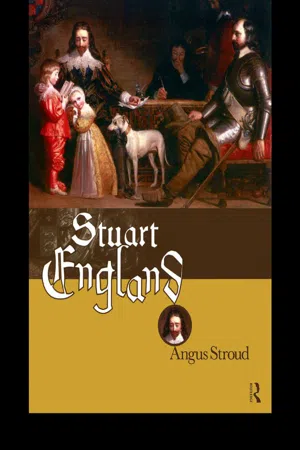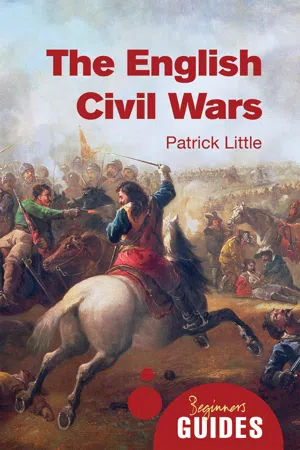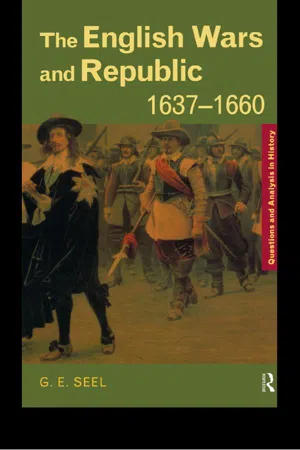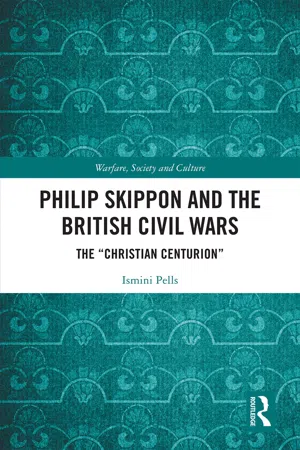History
Rump Parliament
The Rump Parliament was the remaining group of English Parliament members after Pride's Purge in 1648, which saw the expulsion of those who did not support the army's actions. It was responsible for the trial and execution of King Charles I and the establishment of the Commonwealth of England. The Rump Parliament was eventually dissolved by Oliver Cromwell in 1653.
Written by Perlego with AI-assistance
Related key terms
4 Key excerpts on "Rump Parliament"
- eBook - ePub
- Angus Stroud(Author)
- 2002(Publication Date)
- Routledge(Publisher)
Although many historians have criticised the Rump for its relative inaction between 1649 and 1653, the circumstances under which it was working were far from ideal. It lacked the support of much of the political nation, who were alienated from it by its involvement in regicide, and it clearly lacked legitimacy. It was the only one remaining part of the traditional three estates of Parliament. Its members had been elected back in 1641, and, of those, many had been purged by the army. In the circumstances, its claim to rule by the authority of the people was difficult to maintain. Its unpopularity was compounded by the activities of the county committees and the continuation of high levels of taxation that a standing army required. It needed fresh elections to help legit-imise its position, but dared not risk them as they would almost certainly produce an anti-army and possibly even a Royalist majority.The Rump’s reaction to its situation was to avoid any dramatic reform, while trying to portray itself as a guarantor of social and political stability, and thereby gradually win over the support of the conservative élites. This approach had to be balanced with the demands of the army, particularly for further religious reform, on whose support the Rump was dependent for its continued existence.The new Government’s room for manoeuvre was further limited by the financial constraints under which it was working. Initially it enjoyed huge windfalls from the seizure of Crown lands, as well as lands belonging to the bishops and cathedral chapters, and the estates of some 780 leading Royalists, but this was quickly swallowed up by the debts accrued by Parliament in the 1640s, and in paying off the arrears of the army. The political situation dictated that it dare not disband the army, and the costs of maintaining a sizeable standing army were further increased by the wars in Ireland, Scotland and against the Dutch. Taxes were increased and the assessment and excise continued to be levied, but even so the Rump was unable to meet its financial obligations. By April 1653, it was facing a short-fall in revenue of £700,000.The achievements of the Rump
In the domestic sphere, the Rump introduced some cautious changes. It went some way to meeting the old Leveller demands for law reform by changing the language used in proceedings. from old French and Latin to English, although more radical Puritan proposals, such as reforming the law codes along biblical lines, were rejected. Other proposals, for reducing legal fees and improving access to the courts fell foul of the substantial block of lawyer MPs in the Rump, between 60 and 70 of a total membership of 211, who felt their interests threatened by such reforms. - eBook - ePub
The English Civil Wars
A Beginner's Guide
- Patrick Little(Author)
- 2014(Publication Date)
- Oneworld Publications(Publisher)
Charles, who did not share his father’s religious or political scruples, was happy to keep his options open. He held talks with a Scottish delegation in the spring of 1649, but made no firm commitments to them, while at the same time encouraging Ormond. If the Irish plan failed, he would always be able to reopen negotiations with the Presbyterians. For Charles, the English throne was the prize; the means to that end were not of great importance.Creating a British republic
In England, the dramatic events of December 1648 and January 1649 were not followed by the far-reaching revolution that some hoped for and many feared. Even the dismantling of the old system of government was very slow. It was not until 7 February 1649 that the Rump Parliament (so-called because it was only the rump or remnant of the Long Parliament) set up an executive body, to fulfil those functions traditionally performed by the king and his councillors, and, more recently, by a plethora of committees acting under parliamentary authority during the civil wars. This council of state played an important role in controlling the armed forces, and was the focus for diplomacy and foreign policy, but it was firmly under Parliament’s thumb: most of the members were MPs; they were elected by Parliament annually; and their decisions were subject to parliamentary scrutiny. The establishment of an executive was followed by a great deal of constitutional tidying up. In mid-March, acts were finally passed for the abolition of the monarchy and the House of Lords, and it was not until early May that the Rump Parliament voted through another crucial measure – the act declaring England to be ‘a commonwealth and free state’. This last act perhaps typifies the halting, ad hoc nature of the ‘English Revolution’. It consisted of only 105 words, and made no mention of what the republican state might look like – except for the brief comment that it would include neither a monarch nor an upper House of Parliament.The main reason for this apparent reluctance to make positive statements about the new commonwealth was the sense of uncertainty within the Rump Parliament itself. Pride’s Purge had not only removed the Presbyterians and crypto-royalists, but it had also caused the voluntary withdrawal of a large number of less partisan MPs, shocked and dismayed by the army’s actions. In the weeks after the Purge, only around seventy MPs attended the Commons. No more than forty of these were in any sense committed republicans, including Thomas Scot, Henry Marten, and Thomas Chaloner – and by no means were all of these men friends of the army. Aware that the Rump’s legitimacy was under question, the surviving MPs were keen to persuade their former colleagues to return to the House, and gradually those opposed to the regicide – including such republican critics of the army as Sir Henry Vane and Sir Arthur Hesilrige – were coaxed back to Westminster. By February, there were further concessions, aimed at winning over the more moderate MPs secluded at Pride’s Purge, with the only condition being the signing of a ‘dissent’, disowning the Newport Treaty with the late king. Such moves certainly provided a more respectable membership of around 200 (although only around a quarter of these men were present at any one time); but it also brought in yet more conservative MPs, who were keen to limit the power of the army in the commonwealth’s affairs, and who opposed radical reform in church and state. - eBook - ePub
- Graham E. Seel(Author)
- 2005(Publication Date)
- Routledge(Publisher)
Hoping to link up with a series of substantial risings in south Wales, East Anglia, Kent, Yorkshire and other smaller risings elsewhere, Hamilton, a leading Engager, led a Scottish force of ultimately about 20,000 into England on 8 July. However, Hamilton was no military man and his force was destroyed by Cromwell in a running battle around Preston (17–19 August).To army and Leveller disdain, most MPs, agitated by the programme of the radicals and unable to contemplate a settlement without the King, now repealed the Vote of No Addresses (24 August) and urgently resumed negotiations with Charles. If Charles. imprisoned in Carisbrooke Castle on the Isle of Wight since the previous November, acceded to the terms of the Treaty of Newport it appeared to the soldiers that many of their aims, as articulated in the Heads of the Proposals, would be put in jeopardy. Thus, to prevent any such settlement from going ahead, they purged Parliament of all those MPs who had voted to continue negotiations with Charles and others who had shown sympathy to the King or antipathy to the army. The ultimate consequence of Pride’s Purge on 6 December 1648 was the trial and execution of the King, the latter event occurring on 30 January 1649. In the spring of 1649 legislation was enacted that formally abolished the monarchy and the House of Lords.Until April 1653 the purged Parliament (known as the Rump) assumed supreme legislative power. However, three factors in particular meant that it did very little to meet the demands of its creator, the army. First, MPs were obliged instead to concentrate their energies upon securing the new regime from threats from the Levellers, Ireland, Scotland and latterly Holland. Second, the return of some moderate MPs to the Rump meant that its reforming impetus was blunted. Third, increasingly overwhelmed by the practical minutiae of day-to-day government, the Rump enacted very little legislation. Whereas 125 Acts had been passed in 1649 this number declined to only 44 in 1652. In these circumstances Cromwell was persuaded to dissolve the Rump of the Long Parliament on 20 April 1653. Its place was taken by a Nominated Assembly, comprising 139 ‘persons fearing God, and of approved fidelity and honesty’ selected by the army officers.2 However, on 12 December 1653 the moderate majority, increasingly frightened by the actions of the radicals in the Assembly, surrendered their power back to Cromwell.ANALYSIS (1): WHAT CIRCUMSTANCES AND ARGUMENTS WERE DECISIVE IN BRINGING ABOUT THE TRIAL AND EXECUTION OF CHARLES I?
It is a somewhat easier task to suggest reasons why Charles I should not have been executed than to attempt an explanation of why he was. For instance, the Whig interpretation that earlier events were leading inexorably to this climax has been disavowed by recent scholarship, as has the Marxist explanation that the regicide was induced by cumulative social and economic pressures.3 Moreover, it is striking that both before and after the outbreak of the Civil War in 1642 doctrines of non-resistance and passive obedience were widely accepted, instilled by the twin notions of the ‘divine right of kings’ and the social and religious doctrine of the ‘great chain of being’. Biblical texts such as Romans 13 warned that since ‘the powers that be are ordained of God, whosoever therefore resisteth that power, resisteth the ordinance of God. And they that resist…shall receive to themselves damnation.’ Disorder and rebellion were therefore as futile as they were sinful. It is little wonder that Henry Marten was (temporarily) expelled from the Commons in 1643 for arguing a case for a republic. It is also true that when the King was put on trial the Scots let it be known that they considered themselves bound by their Covenant to preserve monarchy. Thus, after Charles I’s execution on 30 January 1649 some of the crowd rushed forward to dip their handkerchiefs in the royal blood, others to collect pocketfuls of earth from below the scaffold. One observer recorded that as the axe fell there was ‘such a groan as I never heard before, and desire I may never hear again’.4 - eBook - ePub
Philip Skippon and the British Civil Wars
The "Christian Centurion"
- Ismini Pells(Author)
- 2020(Publication Date)
- Routledge(Publisher)
111The navy played a crucial role in helping secure the Commonwealth against foreign threats and in May 1649, Skippon had been appointed to the Navy Committee.112 Under the leadership of Sir Henry Vane, this committee reformed the navy, weeding out suspect officers, appointing new, often experienced ones in their place. Salaries were increased and a programme of shipbuilding was initiated. By the outbreak of war against the Netherlands in 1652, the navy had proved its worth. The land campaigns against Ireland and Scotland had been well supported, royalist-held islands in the British Isles had submitted to parliament and Rupert’s navy had been scattered.113 Portuguese support for Rupert was ended following negotiations that began in December 1652, for which Skippon was appointed one of the Council’s commissioners.114Skippon remains infuriatingly silent on the war against the Netherlands. Steven Pincus argued convincingly that initially, the Rump was keen for an alliance and sent an embassy to the Netherlands in January 1651.115 The Dutch response essentially amounted to a trade confederation but said nothing about dealing with “declared enemies”.116 An alliance was particularly resisted by the states under the Prince of Orange’s influence.117 In one fell swoop, the Dutch went (in English eyes) from fellow-Calvinists and republicans to “perfidious ally of the king of Scots”.118 On 9 October 1651, the Rump passed the Navigation Act, based on similar legislation prohibiting trade with Barbados, Virginia, Bermuda and Antigua, which still supported the royalist cause.119 When the Dutch Admiral Van Tromp failed to strike his topsail in the customary manner to the English general-at-sea Robert Blake when their ships met in the Downs on 19 May 1652, open hostilities erupted.120
Learn about this page
Index pages curate the most relevant extracts from our library of academic textbooks. They’ve been created using an in-house natural language model (NLM), each adding context and meaning to key research topics.



